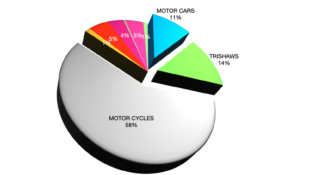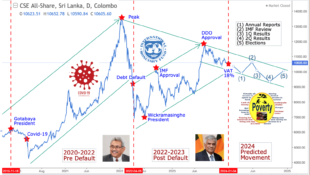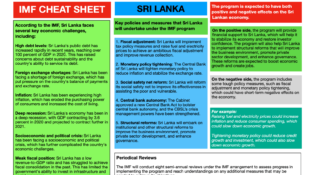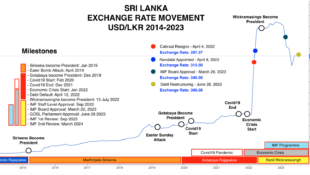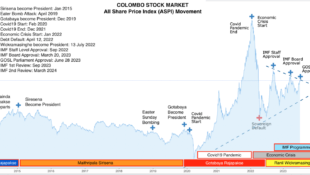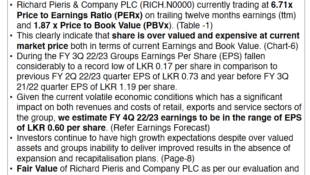The bank can do this by comparing the company with the IPO of another similar company or by calculating the net present value of the firm.
Once trading starts, share prices are largely determined by the forces of supply and demand. A company that demonstrates long-term earnings potential may attract more buyers, thereby enjoying an increase in share prices.
A company with a poor outlook, on the other hand, may attract more sellers than buyers, which can result in lower prices.
In general, prices rise during periods of increased demand - when there are more buyers than sellers. Prices fall during periods of increased supply - when there are more sellers than buyers.
A continuous rise in prices is known as an uptrend and a continuous drop in prices in called a downtrend. Sustained uptrends form a ‘bull’ market and sustained downtrends are called ‘bear’ markets.
Other factors can affect prices and cause sudden or temporary changes in price. Some examples of this include earnings reports, political events, financial reports and economic news.
Not all news or reports affect all securities. Stock prices can also be driven by what is known as herd instinct, which is the tendency for people to mimic the action of a larger group.
For example, as more and more people buy a stock, pushing the price higher and higher, other people will jump on board, assuming that all the other investors must be right (or that they know something not everyone else knows).
There may be no fundamental or technical support for the price increase, yet investors continue to buy because others are doing so and they are afraid of missing out.
Basics of bid-ask spread
You’ve probably heard the terms bid and ask before but you may not know what they mean or how they relate to the stock market.
The bid-ask spread can affect the price at which a purchase or sale is made - and an investor’s overall portfolio return. What this means is that if you want to dabble in the equities markets, you need to become familiar with this concept.
Stock exchanges are set up to assist brokers and other specialists in coordinating bid and ask prices.
The bid price is the amount that a buyer is willing to pay for a particular security. The ask price is the
amount that a seller wants for that security.
The difference between the bid and ask prices is what is called the bid-ask spread.
Supply and demand
Investors must first understand the concept of supply and demand before learning the ins and outs of the spread.
Supply refers to the volume or abundance of a particular item in the marketplace, such as the supply of stock for sale.
Demand refers to an individual’s willingness to pay a particular price for an item or stock.
The price of the stock is determined by supply and demand.
The more individual investors or companies that want to buy, the more bids there will be; more sellers results in more offers or asks.
On the Colombo Stock Exchange (CSE), the Automated Trading System (ATS) is designed to match buy and sell orders placed by the member firms (stockbroking firms) of the CSE.
Investors who have accounts with the Central Depository Systems (Pvt.) Ltd (CDS) place their orders with the brokers, either directly or through a custodian bank.
Orders are entered by the brokers through the ATS trading terminals, which are then transmitted online to the ATS.
The ATS trading terminals are located in the member firms’ offices.
The trading terminal performs three functions- display of market data, display of trader’s orders and executions and acceptance of new orders, amendments and cancellation of orders.
The ATS maintains an order book for each traded security, divided into bids and asks.
The prices are determined and orders executed according to specific rules detailed in the ATS rules of the CSE.
Stock’s bid-ask spread determinants
There are several factors that contribute to the difference between the bid and ask prices.
The most evident factor is a security’s liquidity. This refers to the volume or amount of stocks that are traded on a daily basis.
Some stocks are traded regularly, while others are only traded a few times a day. The stocks and indexes that have large trading volumes will have narrower bid-ask spreads than those that are infrequently traded.
When a stock has a low trading volume, it is considered illiquid because it is not easily converted to cash.
As a result, a broker will require more compensation for handling the transaction, accounting for the larger spread.
Another important aspect that affects the bid-ask spread is volatility. Volatility usually increases during periods of rapid market decline or advancement.
At these times, the bid-ask spread is much wider because market makers want to take advantage of - and profit from - the change.
When securities increase in value, investors are willing to pay more. When volatility is low and uncertainty and risk are at a minimum, the bid-ask spread is narrow.
A stock’s price also influences the bid-ask spread. If the price is low, the bid-ask spread will tend to be larger. The reason for this is linked to the idea of liquidity.
Most low-priced securities are either new or are small in size. Therefore, the number of these securities that can be traded is limited, making them less liquid.
The bid-ask spread can say a lot about a security and therefore, you should be aware of all the reasons that are contributing to the bid-ask spread of a security you are following.
Your investment strategy and the amount of risk that you are willing to take on may affect what bid-ask spread you find acceptable.
Forces that move stock prices
As mentioned above, stock prices are determined in the marketplace, where seller supply meets buyer demand. But unfortunately, there is no clean equation that tells us exactly how a stock price will behave.
That said we do know a few things about the forces that move a stock up or down. These forces fall into three categories: Fundamental factors, technical factors and market sentiment.
Fundamental factors
In an efficient market, stock prices would be determined primarily by fundamentals, which, at the basic level, refer to a combination of two things: 1) An earnings base (earrings per share (EPS), for example) and 2) A valuation multiple (a P/E ratio, for example).
An owner of a stock (ordinary shares) has a claim on earnings and earnings per share (EPS) is the owner’s return on his or her investment.
When you buy a stock, you are purchasing a proportional share of an entire future stream of earnings. That’s the reason for the valuation multiple: It is the price you are willing to pay for the future stream of earnings.
Part of these earnings may be distributed as dividends, while the remainder will be retained by the company (on your behalf) for reinvestment.
We can think of the future earnings stream as a function of both the current level of earnings and the expected growth in this earnings base.
(To be continued)
(Source: Investopedia and Automated Trading Rules of the Colombo Stock Exchange)
http://www.dailymirror.lk/business/features/27512-setting-of-stock-prices-and-forces-that-move-them.html
 would enable you to enjoy an array of other services such as Member Rankings, User Groups, Own Posts & Profile, Exclusive Research, Live Chat Box etc..
would enable you to enjoy an array of other services such as Member Rankings, User Groups, Own Posts & Profile, Exclusive Research, Live Chat Box etc.. 
 Home
Home










